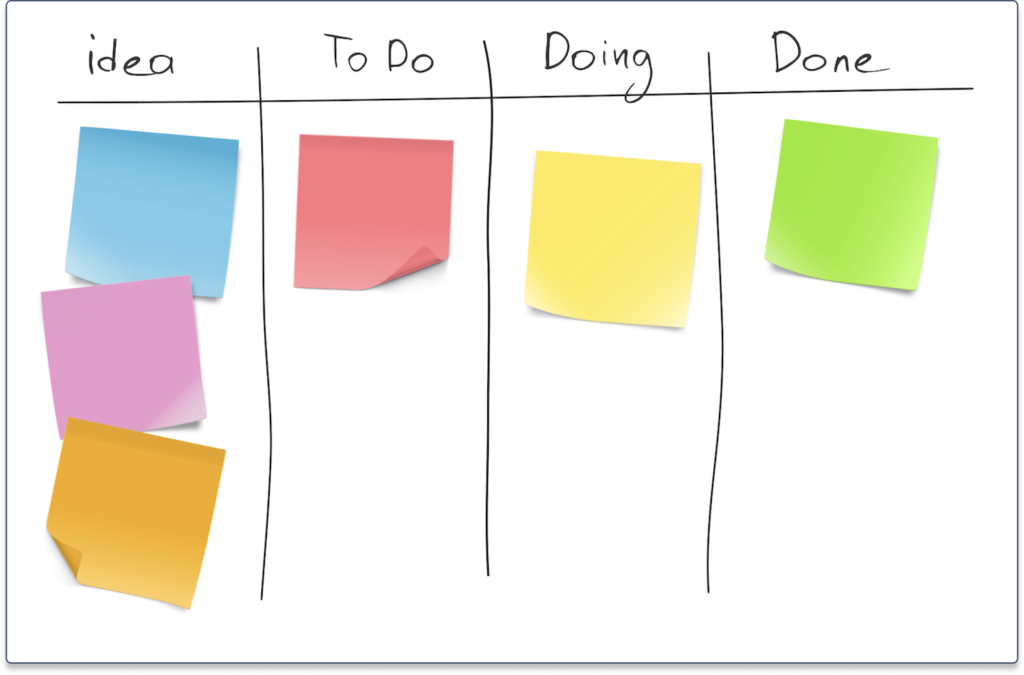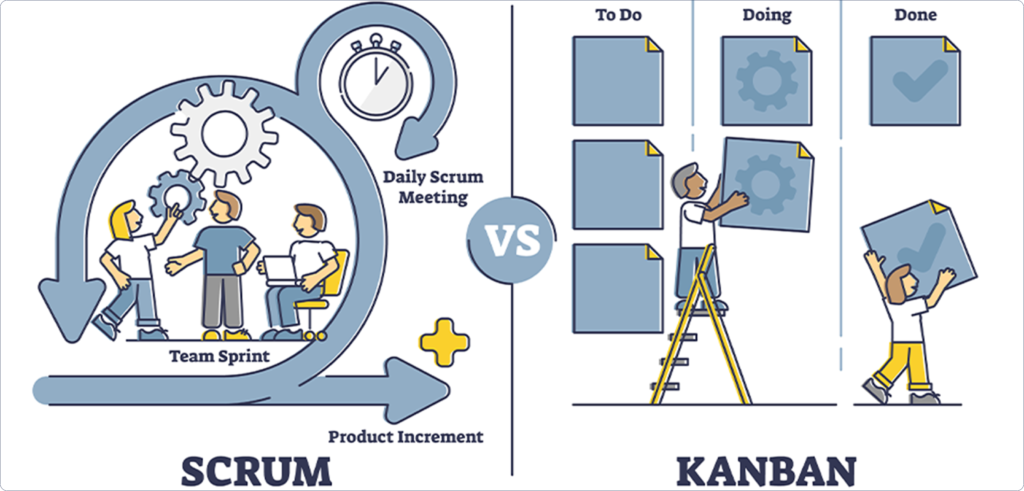5 Agile Project Management Phases to handle projects with flexibility
From the Agile Manifesto to Agile implementation; 5 Agile Project Management phases to manage a project with organization and adaptability


Kanban and Scrum are two agile project management methodologies that are not only used by software houses or IT companies, but they are starting to be appreciated and used also by companies in other fields (marketing, pharmaceutical, etc.).
To better understand what Kanban and Scrum are, it is useful to have an overview of what agile project management is and how it works.
Agile project management is an approach to project management that, as we already know, is a way, supported by knowledge, skills, methodologies, and tools (such as project management software) to develop new products and services.
Project management, and consequently agile project management and Kanban and Scrum approach, follows 3 phases: initiation, planning, and execution.
In developing a project plan these 3 phases must be followed respecting the budget and time of release.
Agile methodology derives from project management and, indeed, it also shares the aim to achieve a goal in different stages and steps.
With project management, we have a big launch or product update, while, with agile management, the goal is split into small chunks (all of them with a specific prioritization) and it has the goal to continuously deliver product updates and new features respecting the planned deliverables.
Agile methodology answers to the nowadays market needs that want competitors able to constantly develop new product/service features or product iterations putting clients ’ feedback and requests first.
Agile is based on 4 principles:
-Individuals and clients ‘necessities come before tools;
-Answering people’s needs instead of following a planned and strict workflow;
-Customer’s listening putting collaboration first;
-Useful and functioning software development over comprehensive documentation.
Agile project management offers a way to be more competitive, fast, and malleable and this is the reason why software houses tend to adopt it instead of the more traditional and “structured” project management one.
If you evaluated that agile methodology is the approach that might help you the most to better work on your project, then you just need to make up your mind and adopt Kanban or Scrum approach.
Both Kanban and Scrum are efficient ways to manage a project and its continuous improvement but, while the Kanban approach has a more fluid and malleable approach, Scrum is more rigid but very fast since it is structured in a brief but intense flow of work (sprints).
To better evaluate which approach suits you better let’s see what Kanban and Scrum work
Kanban is a fluid and continuous agile approach that focuses the attention on a brief, but well-planned and structured flow of work.
It comes from the Japanese word “visual signal” and it helps managers to have a more visual management system since project phases and tasks are represented by cards and find a graphical location on a workflow board.
Kanban was born in the 1940s thanks to the industrial designer at Toyota, Taiichi Ohno, who was looking for an efficient way to keep an eye on every production step and the company’s work in progress.
Kanban mainly focuses on the possibility to visualize work; already completed work, work in progress, and the one that has to come maximizing the efficiency of teams and the project’s process.
Kanban teams have the so-called user stories as their main end goal, and they aim to express the software user’s perspective.
In Kanban methods, the development teams work on software features shaping them based on the user’s perspective and needs.
As we already mentioned in the agile values, we know that high importance is given to stakeholders and their necessities rather than to the tool itself. For this reason, user stories utilize non-technical language to better give team members a “down-to-earth” context that will help them shape human software functionality.
After having understood the user story, the development team knows what its potential client needs to create something valuable.
User stories are at the core of an agile program; without them, the product/service cannot be considered user-focused.
Kanban was thought to visualize work and, for this reason, it relies on boards, cards, columns, work in progress (WIP), commitment points, and delivery points.
All of them help the team to acknowledge and visualize the right amount of work that needs to be done and the current work in progress.
So it is here that the team makes its evaluation and decides if the project has been handled well or not.

The Kanban method can be easily applied to each project or project-based business but is a great approach for all those companies that are working on many projects for different clients with different deadlines and priorities. Indeed, more cards can be added and put before others to pursue a new order of prioritization in the workflow.
Also keeping an eye on a visual workflow help the user to immediately understand what is finished, what needs more effort, and what needs some changes.
To see if everything is going as supposed to, it is important to monitor lead time and cycle time.
With Timeneye you can track the time spent on each project, and its phases, in real-time, keep an eye on your team members’ work, and set email reminders.
Thanks to detailed reports it is possible to receive insightful knowledge about how you and your team have managed the project life cycle and if you were able to stay on time and within budget.
Combining time-tracking software with a project management one is the perfect way to improve a company’s efficiency and productivity and make future project releases easy and stress-free.
Scrum is the most common and used agile project management approach in the whole world, and it was designed for all of those companies that are in a fluid market exposed to changes.
This agile method is stricter than the Kanban approach, but it implies a shorter amount of time, called sprint, that has the main goal to release a feature, product iterations, or a new service.
Scrum methodology is usually adopted by software houses that structure their work on projects, tasks, and activities; all of them at the same time.
Companies that focus a specific amount of time on getting that activity, and tasks done thanks to a great focus of all of the company members, find the scrum method perfect for them.
Scrums usually last 2 weeks and they, indeed, are broken up into sprints that have the goal to focus on single, split tasks.
The team splits complex projects into smaller tasks and activities and each of them is prioritized and put into the calendar with its related deadline.
To better organize the amount of work and its work in progress, the sprints are precisely organized in steps:
· Sprint planning: The goal of this step is to evaluate and decide what has to be done in the sprint and how it should be done (how many employees will be working on it, for how long, etc.). At the beginning of each sprint, in the sprint planning, activities and their deadlines, have to be written down in the sprint backlog.
· Daily Scrum: At the beginning of each sprint day, the team members meet up and decide what are the daily tasks and what they should do, how they have to do it, and if there are common tasks that need reciprocal work. All of these always keep an eye on the sprint backlog.
What matters here is to all be aligned knowing what has been done the day before, what should be done during the day, and if there is a task that needs a collaborative approach.
· Sprint review: In this sprint step the team members should show each other what has been done (acknowledging the priorities written down in the backlog) and talk about what needs to be done in the next future.
· Sprint retrospective: The sprint is completed so it is now time to discuss what has been handled well and what, instead, needs some improvement.
This step is extremely important since it has the goal to find process improvements that might be inspirational for the next sprint.
Scrum is different from Kanban also for what regards the team, its size, and the team members’ roles.
If in the Kanban approach, the development team members work on different tasks of the same project, in Scrum it is possible to do it only when a single task and the role of each team member is strictly related to the single task of the sprint.
The Scrum team usually includes three important roles:
· Scrum master: s/he is the one who leads the team and guides team members with the proper methodology and approach. It is her/his responsibility to meet the deadline, stay on budget and release the product update or feature on time. This also inspires, supports, and motivates the team members to not only reach the goal but, while doing so, improve their competencies and find a better way to collaborate. S/he also has the responsibility to stop the sprint in case something does not go in the right direction.
· Product Owner (PO): S/he brings to the whole team customers and stakeholders feedback. Her/his role is extremely important since it represents the agile project management values for whom the individual comes before the tool. The Product owner translates the user story into a practical need and helps the team to find the proper direction to develop the feature that the clients need.
Daily s/he prioritizes the team activities in the backlog prioritizing what the client needs first.
· Team: the employees who work on the project, translating the user story into product features and developing the sprint project from beginning to end.
Kanban and Scrum methods are agile project management methodologies that help companies to work in an always-changing and competitive environment where users demand useful, easy-to-use, and always new devices.
While the Kanban method is a fluid and continuous approach that makes time and project tasks visualizable, Scrum is a stricter approach that focuses all the team energies on a single sprint.
Both Kanban and Scrum aim to help companies to make better services or products but, while Kanban aims to limit work in progress in favor of maximizing efficiency, Scrum aims to focus on the incrementation of work splitting it into sprints.
Kanban wants to reduce the amount of time that a project takes using Kanban boards while continually improving the workflow.
Scrum adopts specific roles and rules to follow daily to reach the goal in the amount of time decided at first.
What is different is the time approach: in Kanban, the time has to be followed and controlled during the flow of work while, in Scrum, it is already decided and not put into question.

But both of them consider time as the main way to measure if a project has been handled well.
It is indeed important to keep an eye on time integrating your project management tool into Timeneye!
Timeneye is a time tracking software that helps you and your team to track time in real-time, both online and offline, and, thanks to insightful reports, it helps you get the data you need to evaluate if the agile project management you adopted was the right one!
Sign up now and receive your 30-day free trial!
From the Agile Manifesto to Agile implementation; 5 Agile Project Management phases to manage a project with organization and adaptability
Managing teams and projects is no easy task. Take a look at the new Timeneye Status page, where managers can monitor their projects and teams.
Discover why Timeneye made it to the top Time Tracking solutions in 2024 list by Tekpon, offering simple and practical time tracking for freelancers,...